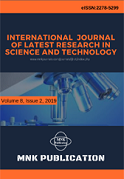DOI:10.29111/ijlrst ISRA Impact Factor:3.35, Peer-reviewed, Open-access Journal
Research Paper Open Access
International Journal of Latest Research in Science and Technology Vol.3 Issue 6, pp 114-120,Year 2014
Correspondence should be addressed to :
Received : 20 December 2014; Accepted : 26 December 2014 ; Published : 31 December 2014

| Download | 125 |
|---|---|
| View | 177 |
| Article No. | 10433 |
Physalin B is a steroidal triterpenoid whose effects on platelet functions are not clearly understood. This paper presents novel in vitro and ex vivo studies on the effects of physalin B on platelet activation and thrombosis formation. Peripheral blood mononuclear cells were cultured to obtain two types of endothelial progenitor cells from the same donors. MTT and cell adhesion assays were performed to evaluate cell viability and the adhesion of THP-1 cells to human umbilical vein endothelial cells (HUVECs), respectively. Biomarkers included prothrombin time (PT) and activated partial thromboplastin time (APTT). The experimental results indicated that physalin B can inhibit the activation of human platelets through an ex vivo interfering arachidonic acid pathway and can block the activation of P2Y12 receptors. Moreover, the antiplatelet function of physalin B does not affect plasma coagulation because both PT and APTT remain unchanged after treatment. Furthermore, physalin B at 80 μM can reduce the TNF-α-induced adhesion of monocytic leukocyte THP-1 cells to HUVECs in a cell adhesion assay. These results suggest that the antithrombotic activity of physalin B is attributed to its antiplatelet activation and antiinflammatory effects. To the best of our knowledge, this study is the first to report on the antiplatelet effect of secosteroidal physalin-type compounds.
Copyright © 2014 Chia-Chun Hsu et al. This is an open access article distributed under the Creative Commons Attribution 4.0 International (CC BY 4.0) license which permits unrestricted use, distribution, and reproduction in any medium, provided the original work is properly cited.
Chia-Chun Hsu,Ping-Yen Liu, Lynn Farh,Wei-Kung Tseng, Kai-Chien Yang, Chau-Chung Wu,Fang-Rong Chang , " Investigation And Characterization Of The Antiplatelet Activities Of Physalin B ", International Journal of Latest Research in Science and Technology . Vol. 3, Issue 6, pp 114-120 , 2014

MNK Publication was founded in 2012 to upholder revolutionary ideas that would advance the research and practice of business and management. Today, we comply with to advance fresh thinking in latest scientific fields where we think we can make a real difference and growth now also including medical and social care, education,management and engineering.

We offers several opportunities for partnership and tie-up with individual, corporate and organizational level. We are working on the open access platform. Editors, authors, readers, librarians and conference organizer can work together. We are giving open opportunities to all. Our team is always willing to work and collaborate to promote open access publication.

Our Journals provide one of the strongest International open access platform for research communities. Our conference proceeding services provide conference organizers a privileged platform for publishing extended conference papers as journal publications. It is deliberated to disseminate scientific research and to establish long term International collaborations and partnerships with academic communities and conference organizers.